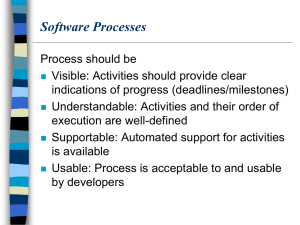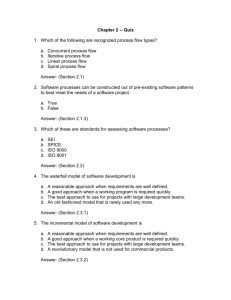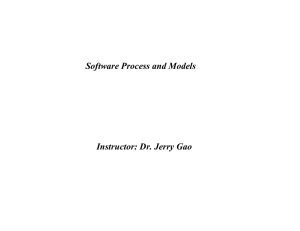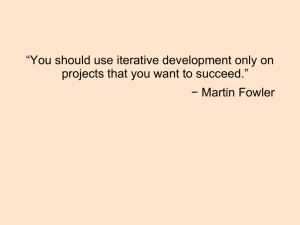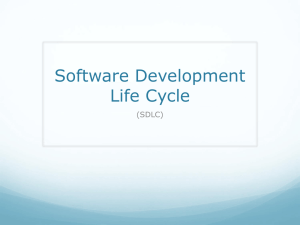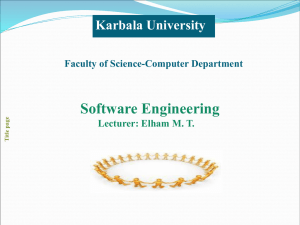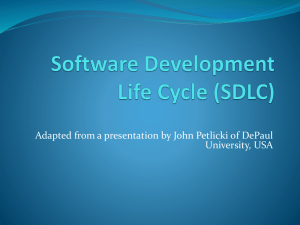Chapter 2
advertisement
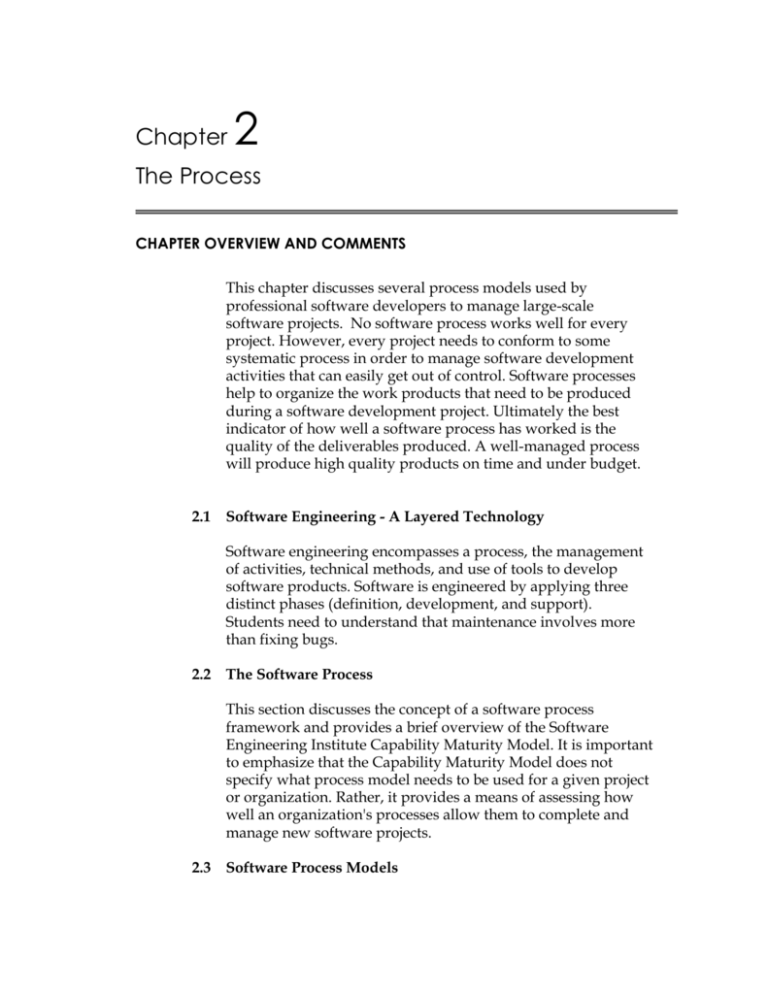
Chapter 2 The Process CHAPTER OVERVIEW AND COMMENTS This chapter discusses several process models used by professional software developers to manage large-scale software projects. No software process works well for every project. However, every project needs to conform to some systematic process in order to manage software development activities that can easily get out of control. Software processes help to organize the work products that need to be produced during a software development project. Ultimately the best indicator of how well a software process has worked is the quality of the deliverables produced. A well-managed process will produce high quality products on time and under budget. 2.1 Software Engineering - A Layered Technology Software engineering encompasses a process, the management of activities, technical methods, and use of tools to develop software products. Software is engineered by applying three distinct phases (definition, development, and support). Students need to understand that maintenance involves more than fixing bugs. 2.2 The Software Process This section discusses the concept of a software process framework and provides a brief overview of the Software Engineering Institute Capability Maturity Model. It is important to emphasize that the Capability Maturity Model does not specify what process model needs to be used for a given project or organization. Rather, it provides a means of assessing how well an organization's processes allow them to complete and manage new software projects. 2.3 Software Process Models The terms "software process model" and "software engineering paradigm" are used interchangeably in the literature. This chapter presents overviews of several software process models. It is easy for students to become so lost in the details of the various process models that they fail to see the features the models have in common with each other. Another difficulty students have is their belief that each phase of a process is performed completely independently of the other phases. The reality is that there tends to be lots overlap among the phases. 2.4 The Linear Sequential Model The linear sequential model is also known as the "classic life cycle" or "waterfall model". System development proceeds though the phases (analysis, design, coding, testing, support) in order. This is a good model to use when requirements are well understood. If a phase must be revisited in this model, process failure is indicated (more thorough requirements analysis is needed). 2.5 The Prototyping Model This model is good to use when the customer has legitimate needs, but is not able to articulate the details at the start of the project. A small mock-up of a working system is developed and presented to the customer. Sometimes this first system is discarded and sometimes it is extended based on the customer's feedback. 2.6 The RAD Model The rapid application deployment model is a high-speed adaptation of the linear sequential model. Project requirements must be well understood and the project scope tightly constrained. Developers are often able to use component-based construction techniques to build a fully functional system in a short time period. 2.7 Evolutionary Models The two most important models in this section are the incremental model and the spiral model. The incremental model combines elements of the linear sequential model applied repetitively with the iterative philosophy of the prototyping model. Each increment produces a working version of a software product with increasing functionality. There is no throwaway code. The spiral model also combines the iterative nature of prototyping with the systematic control found in the linear sequential model. An essential component of the spiral model is that assessment of both management and technical risks is performed as each incremental release is completed. 2.8 Component-Based Development Object-based technologies provide the technical framework for component-based software engineering. The component-based development (CBD) model incorporates many of the iterative characteristics of the spiral model. The main difference is that in CBD the emphasis is on composing solutions from prepackaged software components or classes. This CBD emphasizes software reusability. The unified software development process is an example of CBD that has been proposed for industrial use. The unified modeling language (UML) is used to define the components and interfaces used in the unified software development process. 2.9 The Formal Methods Model Formal methods in software development require the use of rigorous mathematical notation to specify, design, and verify computer-based systems. Mathematical proof is used to verify the correctness of a system (not empirical testing). Cleanroom software engineering is an example of this approach. While formal methods have the potential to produce defect-free software, the development of formal models is both timeconsuming and expensive. 2.10 Fourth Generation Techniques This is a broad class of techniques. The general idea is that a software tool is used to describe a system in manner understood by the customer using a specialized design language or graphical notation. In the ideal case, the tool then generates source code from this system description that can be compiled into a running system. The running system then needs to be tested and refined using other software engineering processes. There is some risk that the customer is not able to describe the system in sufficient detail or that the initial system will be deployed without sufficient testing. Section 2.12 uses a short essay by Margaret Davis to put process and product issues into perspective. If you’re teaching a graduate course, I’d recommend Phillip Howard’s The Death of Common Sense, as outside reading on the failures of a wholly process-oriented mind set. PROBLEMS AND POINTS TO PONDER 2.1. You might suggest that students use the Further Readings and Information Sources section of Chapter 8 for pointers. 2.2. The support phase is applied differently for embedded software. In most cases, embedded software is defined and developed, but once it is placed in its host environment, it is not likely to change until a new release of the product occurs. 2.3. The latest SEI information can be obtained at: http://www.sei.cmu.edu/ 2.4. In each case status quo, problem definition, technical development, and solution integration are applied at a different levels of abstraction. For example, problem definition at the product requirements level would entail many meetings with marketing and even potential end-users; “technical development” at the product requirements level would demand the creation of a product specification; “solution integration” would require detailed review against customer requirements and modifications. At a lower level of abstraction (e.g., generate code ...) the nature of these activities would change, moving away from customer related information and toward implementation specific information. 2.5. Assign this problem as is if the majority of your class is composed of industry practitioners. If your students are "green," suggest a project scenario and ask the students to identify the appropriate paradigm. The key here is to recognize that the "best" paradigm is a function of the problem, the customer, the environment, the people doing the work and many other factors. My choice — all thing being equal — is the evolutionary approach. 2.6. Software applications that are relatively easy to prototype almost always involve human-machine interaction and/or heavy computer graphics. Other applications that are sometimes amenable to prototyping are certain classes of mathematical algorithms, subset of command driven systems and other applications where results can be easily examined without real-time interaction. Applications that are difficult to prototype include control and process control functions, many classes of real-time applications and embedded software. 2.7. Any software project that has significant functionality that must be delivered in a very tight (too tight) time frame is a candidate for the incremental approach. The idea is to deliver functionality in increments. Example: a sophisticated software product that can be released to the marketplace with only partial functionality—new and improved versions to follow! 2.8 Any project in which tight time-lines and delivery dates preclude delivery of full functionality is a candidate for the incremental model. Also any software product in which partial functionality may still be saleable is a candidate. 2.9. As work moves outward on the spiral, the product moves toward a more complete state and the level of abstraction at which work is performed is reduced (i.e., implementation specific work accelerates as we move further from the origin). 2.10. I would suggest postponing this problem until Chapter 27 is assigned, unless you do not intend to assign it. In that case, it can serve to introduce the importance of reuse. 2.11. Stated simply, the concurrent process model assumes that different parts of a project will be a different stages of completeness, and therefore, different software engineering activities are all being performed concurrently. The challenge is to manage the concurrency and be able to assess the status of the project. 2.12. An SQL, a spreadsheet, a CASE code generator, graphical tools like VisualBasic, Powerbuilder, Web page construction tools 2.13. The product is more important! That’s what people use and what provides benefit to end users.
